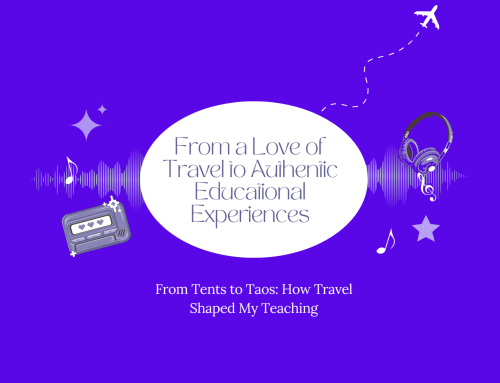When I was a new teacher, I approached lesson planning this way:
1- Identify concepts to teach
2 – Select song material to teach concepts
3 – Consider what materials and instruments were needed
My lessons had a strong sequence of steps and students participated in the activities. Compliance often ruled over engagement as students did what was asked, but they weren’t fully immersed in the experience of learning or adding their own thoughts or ideas into the class. I wasn’t sure how to do this because I was so concerned with figuring out how to keep them on track in learning the concepts they needed to know. My focus was in controlling the sequence of activities so that the lesson gave minimal down time where classroom management played a larger piece than learning and musical experiences could be had by all students. I wasn’t sure how to create opportunities within a well-planned lesson for student input. Or even how to take their input and pivot within a lesson with their idea. It wasn’t that I didn’t want to have student input – I wasn’t sure how to plan for it.
Providing opportunities for student input during a lesson comes with experience over time. It was as I tried one new way for student input during one musical activity and repeated that idea multiple times with multiple classes in multiple grades over multiple musical activities that progress was made in figuring out how to plan for spontaneous and interactive student input during a lesson. It’s planned and spontaneous. The plan includes an opportunity for students to add thoughts and ideas, but what they decide to say or the ideas they share are spontaneous and unrehearsed. As a teacher, you then take their idea and implement it into the experience.
Here are three simple ideas to try that built my confidence in incorporating student input. Try these with your elementary students and see how they unlock student agency!
1 – Students create movements for specific words or phrases
Instead of selecting movements for songs ahead of time, create movements for verses, but allow students to give ideas . Ask students to demonstrate a movement during a phrase or word. Then select one student to share their idea with the class. Ask the entire class to do that motion. You can repeat that process a few times – calling on specific students who you see have shown an idea. Then you determine one of the movement ideas to assign to the word or phrase. Continue the process until the entire verse or words have movements. You may even draw or write down the movements so you remember what was selected. Or ask the students whose ideas were selected to come to the front of the room for the class to follow.
2 – Students determine which instruments play specific rhythms
If a piece calls for rhythm ostinati, you select 3-4 possible instruments that could be used. Invite a student to select the instrument that the class should use. If there are multiple layers of rhythms, invite one student to select which instrument can be played for the first rhythm, another student to select the instrument for a second rhythm and so on until all parts have assigned instruments. Rotate students to play instruments as the class sings the song.
3 – Students create new ideas or new sections using building block rhythms
Here is where Orff and Kodaly training were invaluable for me. Student composition. A little further step away from initial steps for student input during a lesson, but not so much that it’s too intimidating to add in a lesson when first starting out.
Building block rhythms are an essential tool in the Orff Schulwerk approach. It’s a great way to create a B section for a song. One way to use them:
Consider what the theme of a song is that students are learning in class. For example, the song Apple Tree could involve fruit names for the B section. The song Engine Engine Number Nine could involve vehicle names for the B section. Other themes for songs might be sports, cars, food, candy, etc..
For each block, create a word or short phrase (for example, the two quarter notes might be “App-les” and the half note might be “Pear” if the theme was fruit). Provide an opportunity for students to experience speaking each block four times. Choose two blocks for students to speak four times (for example,speaking the two blocks from the earlier example in order “App-les Pear, App-les Pear…”) Ask a student to select two blocks for the class to speak.
Sing or speak the song for section A and then ask the class to speak the selected blocks four times in a row to create section B. Repeat this process and ask another student to select two blocks. Sing or speak the song for section A and then ask the class to speak the newly selected blocks four times in a row to create section B.
In another lesson, you might ask students to create their own 2-block phrase and speak it during the B section. This will result in different combinations being said at the same time. Great for independent work!
And for an extension, consider expanding to a 4-block phrase. Ask students to repeat one of the blocks one time to create a specific form. For example, they might create an ABAC form with the first and third blocks being identical when spoken.
Each of these maintains an element of lesson planning on our part as teachers, but provides students with specific, limited choices so there isn’t choice paralysis for students and opens up opportunities for students to participate in the ideas within a lesson while building engagement and developing critical thinking.




Leave A Comment